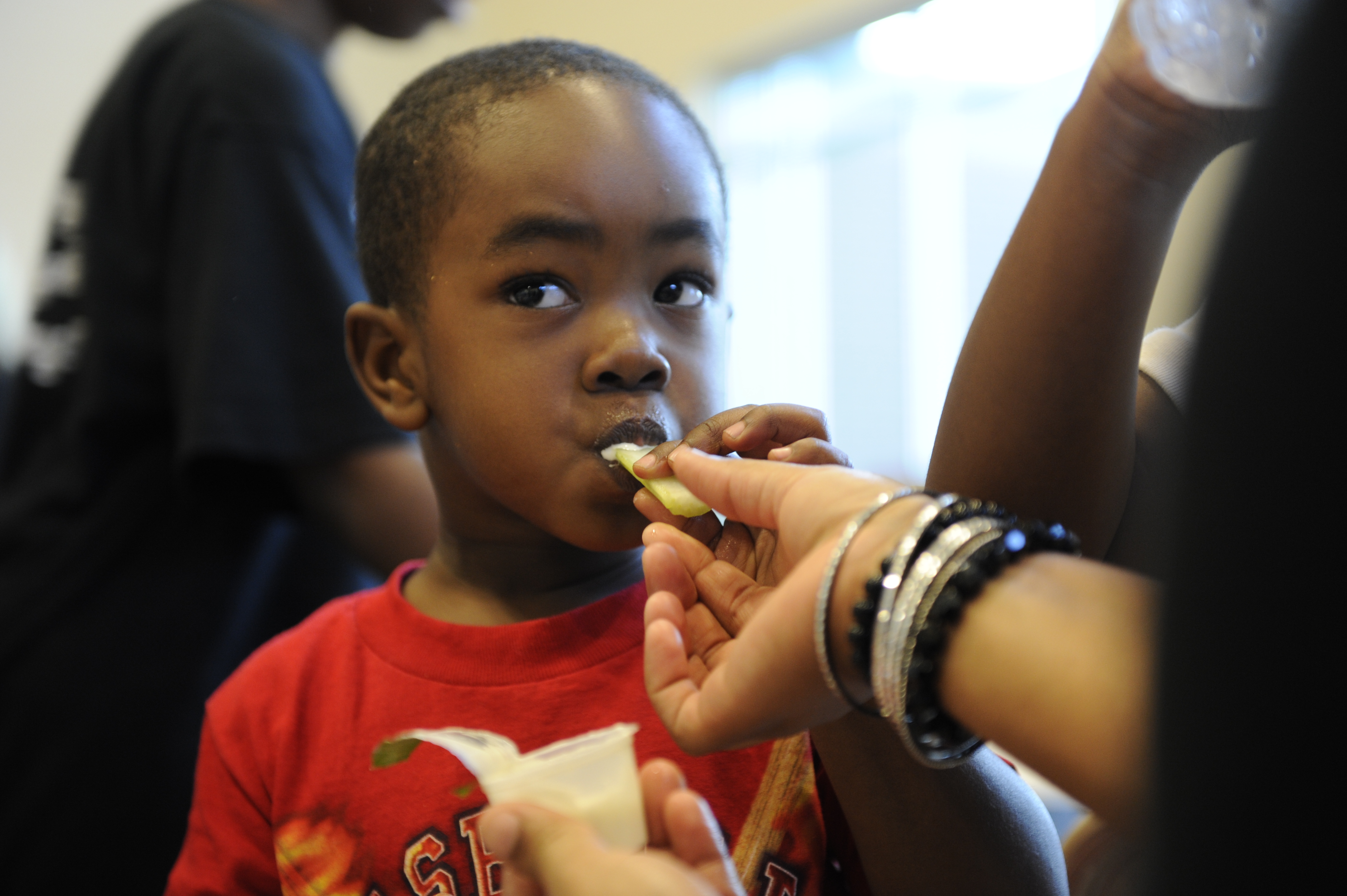PARTICIPATING SCHOOLSBrown International AcademyCalvin Donaldson Environmental Science AcademyEast Lake ElementaryEast Lake AcademyHardy ElementaryOrchard Knob ElementarySource: Hamilton County Department of Education
CAN YOU BELIEVE THEY LIKED IT?Kale, carrot and avocado salad1 bunch kale, stemmed and finely chopped2 cups grated carrots1/2 avocado, peeled and pitted1/4 cup thinly sliced red onion2 tbsp. lemon or lime juice2 tbsp. sesame seeds, toasted1/2 tsp. reduced sodium soy sauceToss all ingredients together in a large bowl. Use your hands or the back of a large spoon to thoroughly mash avocado into kale. Set aside at room temperature for 30 minutes before serving to allow kale to soften.Source: Charlie Loomis, executive chef at Greenlife Grocery
 Alisha Crittenden feeds a celery stick to Amarion Jenkins, 3, during the Chef Nights event at Orchard Knob Elementary Tuesday evening. The event is designed to teach students, parents and faculty the benefits of eating healthy alongside tips for preparing nutritional snacks and meals and promoting physical activity in children.
Alisha Crittenden feeds a celery stick to Amarion Jenkins, 3, during the Chef Nights event at Orchard Knob Elementary Tuesday evening. The event is designed to teach students, parents and faculty the benefits of eating healthy alongside tips for preparing nutritional snacks and meals and promoting physical activity in children.EASY WAYS TO INCORPORATE FRUITS AND VEGGIES* Mix frozen berries with oatmeal* Add broccoli, mushrooms, onions, spinach, pineapple or peppers to pizza* Put bananas on peanut-butter toastHOW TO GET CHILDREN TO EAT MORE PRODUCE* How to get children to eat more produce* Don't leave whole fruit in a bowl or bag; cut it up and keep it at eye level in the refrigerator* Pair fruits with different foods such as yogurt, peanut butter or cheese* Kids like dipping; serve fruits with caramel sauce or vegetables with ranch dressing* Keep it simple, younger children prefer raw produce to cookedSEASONAL CRAVINGS* Our tastes change as the months get cooler. For winter, incorporate roasted butternut squash, sweet potatoes, mushrooms and carrots into your diet. Make them sweet or savory. Instead of high-sugar pies, bake apples or pears with cinnamon and a touch of honey. That will help calm winter cravings for warmth and spice.Source: Dee Harwell, registered dietitian, Dynamic Dietetics and Coordinated School Health
 Jaysen Miller, 6, puts the stethoscope to his ears to listen to his friend's heart during Chef's Night at Orchard Knob Elementary Tuesday evening. The sign behind Miller reads "Children must be healthy to be educated and must be educated to be healthy." The event is designed to teach students, parents and faculty the benefits of eating healthy alongside tips for preparing nutritional snacks and meals and promoting physical activity in children.
Jaysen Miller, 6, puts the stethoscope to his ears to listen to his friend's heart during Chef's Night at Orchard Knob Elementary Tuesday evening. The sign behind Miller reads "Children must be healthy to be educated and must be educated to be healthy." The event is designed to teach students, parents and faculty the benefits of eating healthy alongside tips for preparing nutritional snacks and meals and promoting physical activity in children.Lisa Bass knows kids will eat their vegetables. That is, if they're given the chance.
Bass, the grandmother of four Orchard Knob Elementary School students, volunteers a few times a week, passing out healthy snacks under a federal grant program that pays for fresh fruits and vegetables in schools.
The students can't get enough.
"They love it," she said. "They look forward to the fruits and vegetables."
Bass was among parents and grandparents at a recent "Chef Night" at Orchard Knob, where local chefs and nutrition experts offered samples of healthy recipes and plenty of raw fruits and vegetables for tasting. The locally funded event, which occurs in several Hamilton County schools throughout the year, is aimed at getting children to eat healthier and encouraging parents to incorporate more fruits and vegetables into their everyday cooking.
Healthy eating habits are key in decreasing childhood obesity, which public health officials say has nearly tripled in the last three decades and led to related health complications such as Type 2 diabetes and cardiovascular disease, which may develop later in life.
As of 2007, 36 percent of Tennessee children ages 10 to 17 were overweight or obese, according to the latest figures from Kids Count, a data project of the Baltimore-based Annie E. Casey Foundation. The Center for Disease Control reports that about 12.5 million children and adolescents ages 2 to 19 years are obese. Fighting childhood obesity has become a pet project of First Lady Michelle Obama and internationally known chef Jamie Oliver, among countless other high-profile figures and health officials.
And while schools can work to make breakfast and lunch menus healthier, officials note that what children eat at home is just as important.
Bass said she cooks with vegetables often, but she admitted she could probably still cook healthier.
"I think all of us parents need to do more," she said.
She said she might even try some of Chef Night's featured recipes, which included a vegetarian fried rice and a kale and avocado salad.
Nutrition experts and food service employees also provided many types of raw produce, including celery, broccoli and sliced apples with cheese for the event.
While most students and parents were familiar with the produce and the fried rice, the dark green kale salad took some convincing.
"The ones that try it love it," said Elia Guvist, a Greenlife Grocery chef, who prepared the salad.
Guvist has cooked at several of this year's Chef Nights, where many parents learn how easy it can be to cook healthy, he said. And children gain exposure to new, healthy foods, he said.
"They can kind of shy away from this stuff if they're not used to it," Guvist said. "I think this is a good program because it's exposing kids to raw produce."
Benwood Foundation's Gaining Ground initiative provides the $99,500 for Chef Nights events. The foundation's initiative is aimed at bolstering the production and consumption of local foods.
The evening programs are located at schools in which students receive daytime snacks under the U.S. Department of Agriculture's Fresh Fruit and Vegetable Program. USDA's program chooses schools with the highest rates of students in free- and reduced-price lunch programs.
"We were able to match two good ideas, one from the federal level and one from the local level," said Russell Cliche, who runs Hamilton County's Coordinated School Health division, which cooperatively runs the events with school district nutrition staff.
Cliche said area chefs volunteer their time to make the events successful.
"It works because the chefs give their time," he said.
Carolyn Childs, director of school nutrition for Hamilton County Schools, said the Chefs Night programs highlight the practical uses of cooking with fresh produce -- something officials hope parents will try at home.
"Years ago, everyone cooked with fresh," she said. "But as time evolved, convenience food came into play and everyone started using canned and processed vegetables."
As part of the Benwood grant, school food service workers will soon receive training on how to better incorporate fresh fruits and vegetables into cafeteria meals. Cafeteria workers hope to eventually start showcasing local ingredients in menus.
"That's our goal -- fresh cooking," Childs said, "not just making veggie sticks and salads."
Childs said cafeteria employees sometimes don't have the necessary skills to cook with fresh ingredients. She pointed to broccoli, which cooks can sometimes over steam to the point that it's inedible.
And the time it takes to prepare -- peel, dice or chop -- fresh fruits and vegetables can sometimes be a barrier for cafeteria workers, she said. It's easier and faster to used frozen or canned products, and that goes for all dishes, not just produce.
"Cooking fresh is labor-intensive," Childs said. "So over the years, we've pared down."
That's something Jowan Upshaw knows all too well. Because of time constraints, she said most of her cooking with fresh produce is saved for Sundays.
"I do more fresh vegetables on Sundays because I have more time," she said.
Upshaw visited Orchard Knob's Chef Night with her 6-year-old daughter Princess Wells.
While her first-grade daughter was content with the broccoli, Upshaw said she was grateful for the cooking methods she learned.
"It really did give me more ideas on ways to fix easier healthy meals," she said.
